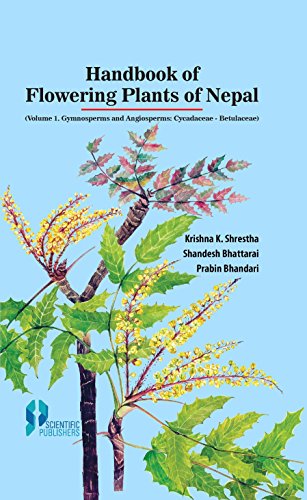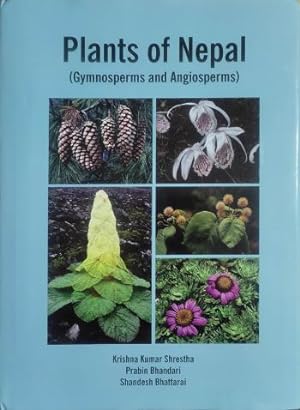Krishna Shrestha Shandesh Bhattarai Prabin (3 results)
Product Type
- All Product Types
- Books (3)
- Magazines & Periodicals
- Comics
- Sheet Music
- Art, Prints & Posters
- Photographs
- Maps
-
Manuscripts &
Paper Collectibles
Condition
Binding
Collectible Attributes
- First Edition (2)
- Signed
- Dust Jacket (1)
- Seller-Supplied Images (1)
- Not Printed On Demand
Seller Location
Seller Rating
-
Plants of Nepal (Gymnosperms and Angiosperms)
Published by Heritage Publishers & Distributors, Kathmandu, 2022
ISBN 10: 9937774527ISBN 13: 9789937774529
Seller: Yak and Yeti Books, Denver, CO, U.S.A.
Book First Edition
Hardcover. Condition: Near Fine. Dust Jacket Condition: Near Fine. 1st Edition. xiii, 1,088p, ills, map on e/ps. On the history of botanical explorations, plant collection, documentation and nomenclature of plant resources of Nepal from the early 19th century to the present.
-
Handbook of Flowering Plants of Nepal: Vol. I
Published by Scientific Publisher, 2018
ISBN 10: 9387307107ISBN 13: 9789387307100
Seller: Vedams eBooks (P) Ltd, New Delhi, India
Book First Edition
Hardcover. Condition: New. 1st Edition. Contents: 1. Introduction. 2. Spermatophyta. 3. GYMNOSPERMS. 4. CYCADALES. 5. Cycadaceae. 6. GINKGOALES. 7. Ginkgoaceae. 8. GNETALES. 9. Gnetaceae. 10. EPHEDRALES. 11. Ephedraceae. 12. PINALES.13. Pinaceae. 14. ARAUCARIALES. 15. Araucariaceae. 16. Podocarpaceae. 17. CUPRESSALES. 18. Cupressaceae. 19. Taxaceae. 20. ANGIOSPERMSNY. 21. MPHAEALES. 22. Nymphaeaceae. 23. AUSTROBAILEYALES.24. Schisandraceae. 25. PIPERALES. 26. Saururaceae. 27. Piperaceae. 28. Aristolochiaceae. 29. MAGNOLIALES. 30. Myristicaceae. 31. Magnoliaceae. 32. Annonaceae. 33. LAURALES. 34. Lauraceae. 35. CHLORANTHALES. 36. Chloranthaceae. 37. MONOCOTS. 38. ACORALES. 39. Acoraceae. 40. ALISMATALES.41. Araceae. 42. Tofieldiaceae. 43. Alismataceae. 44. Hydrocharitaceae. 45. Aponogetonaceae. 46. Juncaginaceae. 47. Potamogetonaceae. 48. DIOSCOREALES. 49. Nartheciaceae. 50. Burmanniaceae. 51. Dioscoreaceae. 52. PANDANALES. 53. Pandanaceae. 54. LILIALES. 55. Melanthiaceae. 56. Colchicaceae. 57. Smilacaceae. 58. Lliliaceae. 59. ASPARAGALES. 60. Orchidaceae.61. Hypoxidaceae. 62. Iridaceae. 63. Asphodelaceae. 64. Amaryllidaceae. 65. Asparagaceae. 66. ARECALES. 67. Arecaceae. 68. COMMELINALES. 69. Commelinaceae. 70. Pontederiaceae. 71. ZINGIBERALES. 72. Musaceae. 73. Cannaceae. 74. Marantaceae. 75. Costaceae. 76. Zingiberaceae. 77. POALES. 78. Typhaceae. 79. Bromeliaceae. 80. Xyridaceae. 81. Eriocaulaceae. 82. Juncaceae. 83. Cyperaceae. 84. Poaceae. 85. EUDICOTS. 86. Papaveraceae. 87. Circaesteraceae. 88. Lardizabalaceae. 89. Menispermaceae. 90. Berberidaceae. 91. Ranunculaceae. 92. PROTEALES. 93. Sabiaceae. 94. Nelumbonaceae. 95. Platanaceae. 96. Proteaceae. 97. TROCHODENDRALES. 98. Trochodendraceae. 99. BUXALES. 100. Buxaceae. 101. CORE EUDICOTS. 102. DILLENIALES. 103. Dilleniaceae. 104. SAXIFRAGALES.105. Paeoniaceae. 106. Hamamelidaceae.107. Daphniphyllaceae. 108. Grossulariaceae. 109. Saxifragaceae. 110. Crassulaceae. 111. Haloragaceae. 112. ROSIDS. 113. VITALES. 114. Vitaceae. 115. ZYGOPHYLLALES.116. Zygophyllaceae. 117. FABALES. 118. Fabaceae. 119. Polygalaceae. 120. ROSALES. 121. Rosaceae.122. Elaeagnaceae. 123. Rhamnaceae. 124. Ulmaceae. 125. Cannabaceae. 126. Moraceae. 127. Urticaceae. 128. FAGALES. 129. Fagaceae. 130. Myricaceae. 131. Juglandaceae. 132. Casuarinaceae. 133. Betulaceae. Appendices. The Handbook of Flowering Plants of Nepal will be published in two volumes Volume 1 comprises 91 families (Cycadaceae Betulaceae), 696 genera and ca. 3004 taxa (2857 species, 33 subspecies, 113 varieties, and 1 forma) of gymnosperms and flowering plants (nearly 40 percent species of Nepal flora) It also includes 103 species of exotic species, and 137 species of doubtful or uncertain species The volume two will comprise remaining species belonging to Coriariaceae Apiaceae Additional information includes information on Type specimen of endemic species of Nepal Similarly, Nepali names, English names, life forms, elevation ranges, and general distribution are provided for each species Furthermore, economic use values of most of the species (with parts use), and information on species with IUCN Red List category, and CITES Appendices are also provided. This book represents a major stepping-stone on the pathway in completing the Flora of Nepal, and is an indispensible resource for anyone working on Nepalese plants .
-
Plants of Nepal: Gymnosperms and Angiosperms
Published by Heritage Publishers and Distributors Pvt. Ltd, 2022
ISBN 10: 9937774527ISBN 13: 9789937774529
Seller: Vedams eBooks (P) Ltd, New Delhi, India
Book
Soft cover. Condition: New. Contents: Foreword. Preface. Herbarium codes. Abbreviations and Acronyms. 1. Introduction. 2. Checklist. i. Gymnosperms and Angiosperms: Extended Checklist. ii. Uncertain species: Synoptical Checklist. iii. Exotic (Planted/Cultivated) Species: Synoptical Checklist. Taxonomic references. Use References (Bibliography). Appendices. Photo Plates. Index to Scientific Names. Index to Local Names. Index to English Names. Synopsis. The Authors. This book is about the history of botanical explorations, plant collection, documentation and nomenclature of plant resources of Nepal from the early 19th century to the present. It encompasses comprehensive information on plant diversity, plant resources, ethnobotany and flora of Nepal, especially the Gymnosperms (Cycadaceae Taxaceae) and Angiosperms (Nymphaeaceae Apiaceae) described from Nepal, representing all seven provinces and 77 districts of Nepal, and from a wide elevational range: as low as 60 m (Jhapa) to 6400 m (base of the Mount Everest, Solukhumbu), East Nepal. The arrangement of families in the book is based on the APG system of classification, while the genera and species are arranged in alphabetical order. Emphasis is given to three categories of plants: extended checklist of native and naturalized species; synoptic checklist of uncertain species (lacking sufficient information on its occurrence in Nepal); and synoptic checklist of exotic species (planted or cultivated species) documented from Nepal. An attempt has been made to provide the latest nomenclature of the species, with synonyms, local names and English names, life form or habit; distribution in Nepal, elevational ranges, and global distribution. In addition, information on endemic plants, threatened plants, naturalized and invasive species of Nepal; use-value of the majority of species; and citation of voucher or herbarium specimens, for each species reported from Nepal, are also provided. This book should be useful to a wide range of readers, from students, teachers and researchers in the field of botany, forestry, agriculture, and floriculture, to policy-makers and all who are interested in the plants of Nepal.




